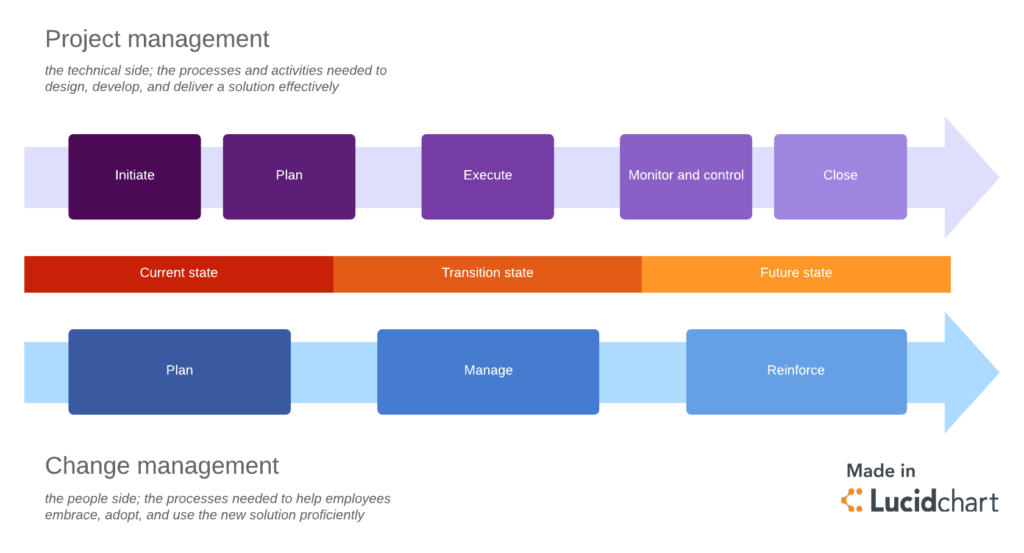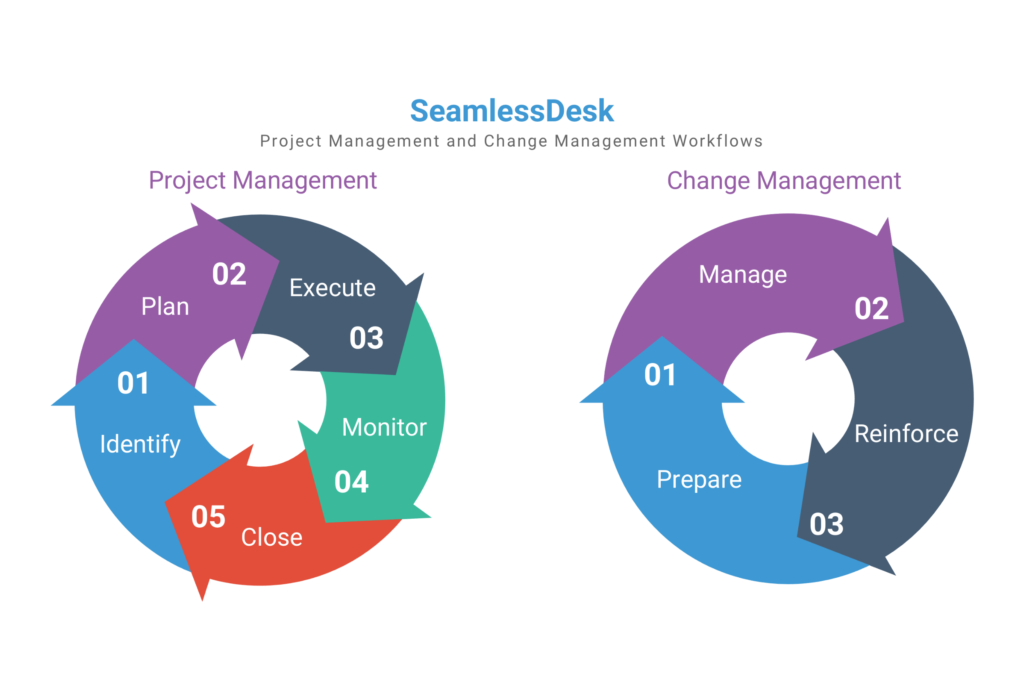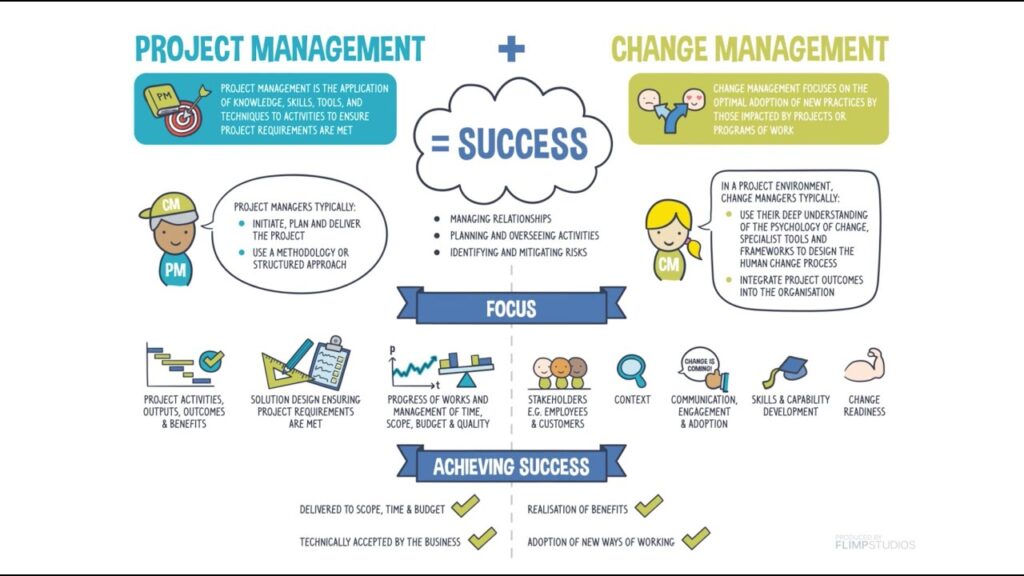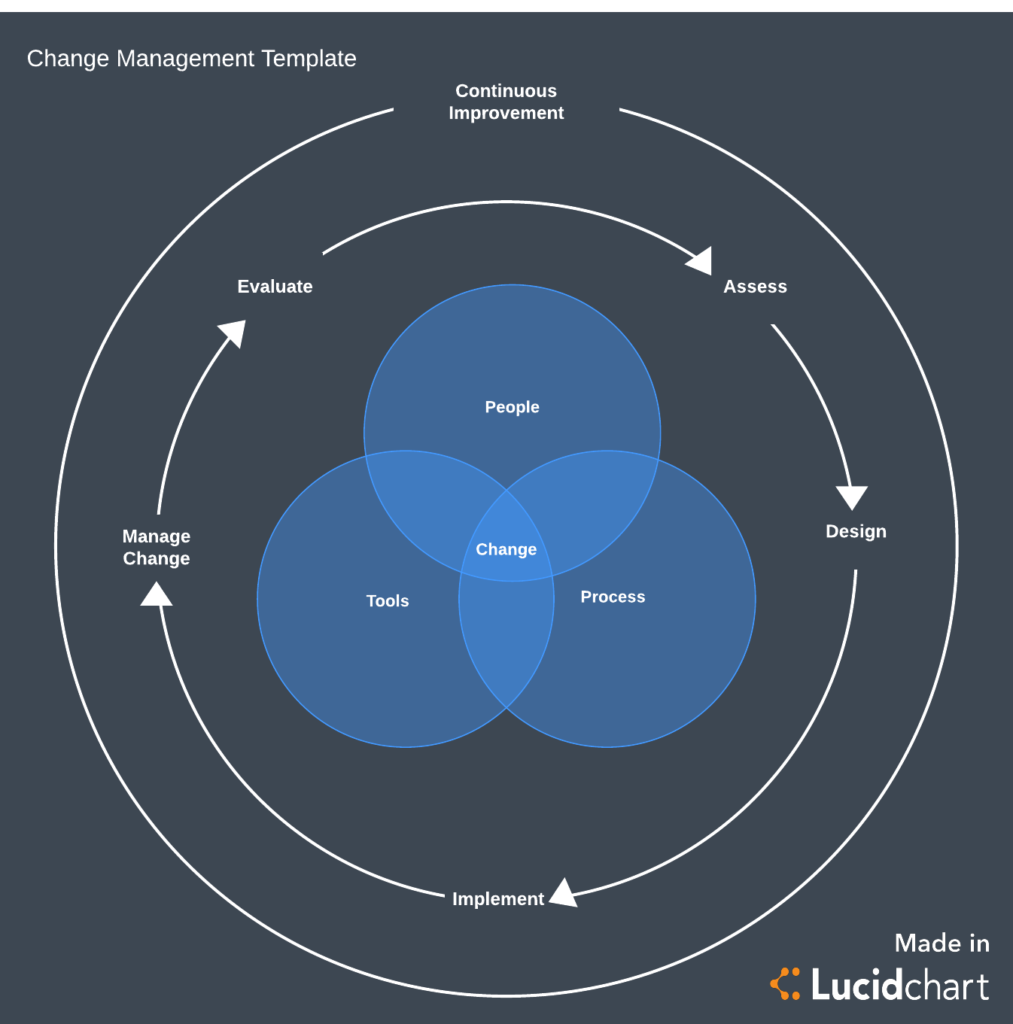
Are you familiar with the concept of change management in project management? If not, don’t worry, because this article will provide you with a clear understanding of what it entails. Change management is a crucial aspect of project management that focuses on successfully implementing and managing changes within a project. It encompasses various strategies and techniques aimed at minimizing resistance and maximizing adoption of these changes. In this article, we will explore the importance of change management and its role in ensuring project success. So, let’s dive in and gain a deeper understanding of this fascinating subject!
Understanding Change Management in Project Management
Change management plays a crucial role in project management, ensuring that any changes to a project are effectively planned, implemented, and sustained. It involves a systematic approach to managing and controlling changes to project objectives, timelines, resources, and deliverables. By proactively managing change, project managers can minimize risks, increase project success rates, and enhance organizational performance. In this article, we will explore the definition of change management, its importance in project management, key principles, types of changes, common challenges, change management models, tools and techniques, benefits, and best practices.
Definition of Change Management
Change management refers to the processes, tools, and techniques used to manage the people side of change within an organization. It involves systematic planning, communication, training, and monitoring to ensure that individuals and groups affected by a project or organizational change can adapt and transition successfully. Change management encompasses understanding the need for change, preparing for change, implementing change, monitoring and evaluating change, and sustaining change.

Importance of Change Management in Project Management
Change is inevitable in any project, and without proper change management, projects can encounter delays, cost overruns, and stakeholder dissatisfaction. Effective change management is vital to ensure project success by minimizing risks and maximizing the positive impact of change. It allows for a smooth transition and ensures that all stakeholders are engaged, informed, and ready to embrace the change. By integrating change management into project management, organizations can increase their ability to adapt to external changes, improve employee satisfaction and engagement, and enhance overall organizational performance.
Change Management Process
The change management process involves a series of steps to effectively manage change within a project. These steps include identifying the need for change, planning and preparing for change, implementing change, monitoring and evaluating change, and sustaining change. Each step is critical in ensuring the successful adoption and integration of change within the project and organization.
Identifying the Need for Change
The first step in the change management process is to identify the need for change. This involves understanding the reasons behind the change, assessing the current situation, and determining if and why change is necessary. Project managers and stakeholders must analyze the impact and feasibility of the proposed change, considering factors such as project objectives, resources, risks, and potential benefits. By clearly identifying the need for change, project teams can tailor their change management strategies and ensure that change is purposeful and well-informed.
Planning and Preparing for Change
Once the need for change is identified, the next step is to plan and prepare for change. This includes creating a detailed change management plan that outlines the objectives, scope, timeline, and resources required for the change. Project managers must consider the potential risks and challenges associated with the change and develop mitigation strategies accordingly. Additionally, it is crucial to communicate the change plan to all stakeholders, ensuring that they understand the purpose and expected outcomes of the change. Adequate preparation and planning set the foundation for successful change implementation.
Implementing Change
After the change plan is developed and communicated, the implementation phase begins. This involves executing the planned activities, such as modifying processes, systems, or organizational structures, introducing new technologies, or changing roles and responsibilities. Effective change implementation requires strong leadership, clear communication, and stakeholder engagement. Project managers must ensure that the change is implemented in a controlled and systematic manner, minimizing disruption and maximizing adoption among team members and stakeholders.
Monitoring and Evaluating Change
Once the change is implemented, it is essential to monitor and evaluate its effectiveness. This involves gathering feedback from stakeholders, assessing the impact on project objectives and deliverables, and tracking key performance indicators (KPIs). Monitoring and evaluation help project managers identify any gaps or areas for improvement and make necessary adjustments. Regular communication with stakeholders, including post-implementation reviews, allows for ongoing evaluation and continuous improvement of the change management process.
Sustaining Change
Sustaining change is the final phase of the change management process, and it involves ensuring that the change becomes embedded within the project and organization’s culture and practices. This requires ongoing support, reinforcement, and communication to maintain the change and prevent any regression to previous practices. Project managers should celebrate successful change implementation and communicate the positive outcomes to motivate and encourage stakeholders. By sustaining change, organizations can drive long-term success and make continuous improvements to their projects and operations.

Key Principles of Change Management
To effectively manage change within a project, there are several key principles that project managers should follow. These principles provide a guiding framework for implementing change and ensuring its success.
Strong Leadership
Strong leadership is crucial for driving change within a project. Leaders must inspire, motivate, and guide team members through the change process. They should provide a clear vision and direction, establish expectations, and help individuals overcome resistance to change. By leading by example and demonstrating commitment to the change, project managers can create a positive change culture within the organization.
Effective Communication
Effective communication is essential in change management. Project managers must ensure that stakeholders are informed about the change, its purpose, and the expected outcomes. Clear and transparent communication helps alleviate fears and concerns, builds trust, and promotes stakeholder engagement. Different communication channels should be utilized, including face-to-face meetings, emails, newsletters, and project management software, to reach all stakeholders effectively.
Stakeholder Engagement
Engaging stakeholders throughout the change process is critical for successful change management. Project managers should involve stakeholders from the early stages of change planning, seek their input and feedback, and address any concerns or resistance. By actively involving stakeholders, project managers can gain their support and commitment to the change, enhancing the likelihood of successful adoption.
Risk Management
Change inherently comes with risks, and effective risk management is essential in change management. Project managers should identify potential risks associated with the change, assess their impact and likelihood, and develop strategies to mitigate or manage them. By being proactive in risk management, project teams can anticipate challenges and prevent them from derailing the change process.
Adaptability and Flexibility
Projects and organizations operate in dynamic environments, and change management requires adaptability and flexibility. Project managers should be open to feedback and be willing to adjust the change plan based on new information or evolving circumstances. By being flexible and adaptable, project teams can navigate unforeseen challenges and make necessary adjustments to ensure the success of the change initiative.
Types of Changes in Project Management
In project management, various types of changes can occur during the lifecycle of a project. These changes can have different impacts on the project and require tailored change management strategies. Some common types of changes in project management include:
Organizational Changes
Organizational changes impact the structure, culture, and processes of an organization. This can include changes in leadership, mergers or acquisitions, reorganizations, or changes in policies and procedures. Organizational changes often require extensive change management efforts due to the potential impact on employees, teams, and the overall organization.
Technological Changes
Technological changes involve the adoption or implementation of new technologies, systems, or processes within a project or organization. This can include the introduction of new software, hardware upgrades, automation, or digital transformations. Technological changes often require training and support to ensure successful adoption and integration.
Procedural Changes
Procedural changes involve modifications to existing processes, workflows, or procedures within a project or organization. This can include streamlining processes, introducing new project management methodologies, or changes in quality control processes. Procedural changes may require training, documentation updates, and clear communication to ensure team members understand and adopt the new procedures.
Cultural Changes
Cultural changes involve shifts in the values, beliefs, and behaviors of individuals and groups within an organization. This can include changes in attitudes towards collaboration, innovation, or diversity and inclusion. Cultural changes often require strong leadership, effective communication, and stakeholder engagement to ensure that the desired culture shift is embraced by all team members.

Common Challenges in Change Management
While change management is critical in project management, it is not without its challenges. Identifying and addressing these challenges is essential to ensure successful change implementation. Some common challenges in change management include:
Resistance to Change
Resistance to change is one of the most significant challenges in change management. Individuals may resist change due to fear of the unknown, loss of control, or perceived negative consequences. Overcoming resistance requires effective communication, addressing concerns, and involving individuals in decision-making processes.
Lack of Support from Stakeholders
Lack of support from stakeholders can impede the success of change initiatives. If key stakeholders do not understand or believe in the change, they may not provide necessary resources, influence, or support. Engaging stakeholders from the early stages of change planning and addressing their concerns can help generate support and buy-in.
Unclear Goals and Objectives
Unclear goals and objectives can create confusion and resistance to change. If individuals do not understand the purpose and expected outcomes of the change, they may be hesitant to embrace it. Clear communication and setting SMART (Specific, Measurable, Attainable, Relevant, Time-bound) goals and objectives can help align individuals and teams towards a shared vision.
Inadequate Resources
Insufficient resources, such as time, budget, or skilled personnel, can hinder change implementation. Without adequate resources, projects may face delays, quality issues, or failure to achieve desired outcomes. Project managers must ensure that they have the necessary resources to support the change and adjust project plans accordingly.
Poor Communication
Poor communication can lead to misunderstandings, rumors, and resistance to change. It is essential to communicate the change purpose, benefits, and expected outcomes clearly and consistently. Two-way communication and active listening are essential to address concerns, provide updates, and ensure that stakeholders are informed and engaged throughout the change process.
Change Management Models
Change management models provide structured frameworks for managing and implementing change within projects and organizations. These models offer step-by-step processes and strategies to facilitate change and maximize its effectiveness. Some commonly used change management models include:
Lewin’s Change Management Model
Lewin’s Change Management Model, developed by Kurt Lewin, consists of three stages: unfreezing, change, and refreezing. Unfreezing involves creating awareness of the need for change and preparing individuals and teams for the change. The change stage involves implementing the desired change, and refreezing is about reinforcing and institutionalizing the change within the organization.
Kotter’s 8-Step Change Model
Kotter’s 8-Step Change Model, developed by John Kotter, provides a detailed roadmap for successful change implementation. The eight steps include creating a sense of urgency, forming a guiding coalition, developing a vision and strategy, communicating the change vision, empowering employees, generating short-term wins, consolidating gains, and anchoring the change in the organization’s culture.
ADKAR Model
The ADKAR Model, created by Prosci, focuses on individual change and the stages individuals go through when undergoing change. ADKAR stands for Awareness, Desire, Knowledge, Ability, and Reinforcement. By addressing these five dimensions, change managers can facilitate successful individual transitions.
Prosci’s ADKAR Model
Prosci’s ADKAR Model builds upon the original ADKAR Model by incorporating organizational change management processes. It includes five phases: preparing for change, managing change, reinforcing change, integrating change management, and evaluating change management effectiveness. This model helps organizations approach change from both individual and organizational perspectives.
McKinsey 7-S Model
The McKinsey 7-S Model is a holistic approach to change management that focuses on seven key elements: strategy, structure, systems, shared values, skills, style, and staff. This model emphasizes the interconnectedness of these elements and the need to align them for successful change implementation.

Change Management Tools and Techniques
To support change management efforts, various tools and techniques can be utilized. These tools help project managers and change managers plan, implement, and monitor change effectively. Some common change management tools and techniques include:
Change Impact Assessment
Change impact assessment involves analyzing the potential impact of a change on various aspects of a project or organization. This includes assessing the impact on processes, systems, resources, stakeholders, and overall project objectives. Change impact assessment helps identify potential risks, challenges, and mitigation strategies required for successful change implementation.
Resistance Management
Resistance management focuses on addressing resistance to change. It involves identifying potential sources of resistance, developing strategies to mitigate resistance, and providing support and training to individuals and teams to navigate change successfully. Resistance management includes communication, education, involvement, and addressing concerns to reduce resistance and increase change adoption.
Communication Plan
A well-defined communication plan is crucial in change management. It outlines the key messages, communication channels, target audiences, and frequency of communication. The communication plan ensures that stakeholders receive timely and relevant information about the change, helping to build understanding, trust, and engagement.
Training and Development
Training and development play a vital role in change management, especially for technological or procedural changes. This involves providing training sessions, workshops, or e-learning modules to equip individuals with the skills and knowledge needed to adapt to the change. Training should be tailored to the specific needs of individuals and teams and may include hands-on practice, job aids, or coaching.
Change Control Board
A change control board is a governance body responsible for evaluating, prioritizing, and approving or rejecting proposed changes. It helps ensure that all changes are aligned with project objectives, scope, and constraints. The change control board provides a structured and standardized process for change evaluation, ensuring that changes are implemented in a controlled and well-managed manner.
Benefits of Effective Change Management
Effective change management brings a range of benefits to projects and organizations. By prioritizing change management efforts, organizations can maximize the positive impact of change and minimize resistance and negative consequences. Some key benefits of effective change management include:
Minimizing Resistance and Negative Impact
By proactively managing change, organizations can reduce resistance and mitigate negative consequences. Effective change management strategies help individuals and teams understand the purpose and benefits of change, address concerns, and provide necessary support, leading to a smoother transition and increased change adoption.
Increased Project Success Rate
Change management is closely linked to project success. By integrating change management practices into project management, organizations can increase the likelihood of achieving project objectives, meeting timelines, and delivering desired outcomes. Effective change management enhances project control, reduces risks, and ensures alignment with stakeholders’ expectations.
Improved Employee Satisfaction and Engagement
Change can have a significant impact on employees, and effective change management promotes employee satisfaction and engagement. By involving employees in the change process, providing support and training, and recognizing their contributions, organizations can foster a positive change culture and enhance employee morale, productivity, and loyalty.
Enhanced Organizational Performance
Change management contributes to enhanced organizational performance by improving processes, increasing efficiency, and fostering a culture of innovation and adaptability. By managing change effectively, organizations can streamline operations, optimize resource utilization, and drive continuous improvement, resulting in better overall performance and competitiveness.
Adaptability to External Changes
In today’s dynamic business environment, organizations must be adaptable to external changes. Effective change management builds organizational resilience and the ability to respond quickly and effectively to emerging trends, market shifts, or regulatory requirements. It enables organizations to stay proactive and seize opportunities while minimizing disruption.

Change Management Best Practices
Following best practices in change management can increase the likelihood of change success and maximize its benefits. Some key change management best practices include:
Engage and Involve Stakeholders
Engaging and involving stakeholders from the early stages of change planning is critical. By seeking their input, addressing concerns, and involving them in decision-making processes, organizations can generate support and commitment towards the change. Regular communication and feedback channels should be established to keep stakeholders informed and engaged throughout the change process.
Communicate Transparently and Effectively
Communication is a cornerstone of change management. It is essential to communicate the change purpose, benefits, and expected outcomes clearly and transparently. Project managers should tailor communication messages to different stakeholder groups, utilize various communication channels, and provide regular updates to maintain trust and alignment.
Develop a Change Management Plan
A well-defined change management plan is essential for successful change implementation. The plan should outline the change objectives, scope, timeline, resource requirements, and key activities. It should also include a risk management strategy, communication plan, and stakeholder engagement approach. The change management plan provides a roadmap for change implementation and serves as a guide for project teams.
Anticipate and Address Resistance
Resistance to change is common and should be anticipated and addressed proactively. Project managers should identify potential sources of resistance, involve resistant individuals, and address their concerns and fears through open and honest communication. Resistance should be viewed as an opportunity to gather feedback and refine change strategies, rather than as a barrier to change.
Continuously Monitor and Evaluate Progress
Monitoring and evaluating change progress are essential to identify any gaps or areas for improvement. Project managers should define key performance indicators (KPIs) to track and measure the success of change implementation. Regular review meetings and post-implementation assessments should be conducted to gather feedback, assess the impact of change, and make necessary adjustments.
Conclusion
Change management is an integral part of project management, ensuring that changes are effectively planned, implemented, and sustained. By following the change management process and adhering to key principles, project managers can navigate the complexities of change, engage stakeholders, and maximize the positive impact of change. Understanding the different types of changes, common challenges, and available change management models and tools enables organizations to develop robust change management strategies. By embracing change management best practices, organizations can enhance their ability to adapt to external changes, increase project success rates, improve employee satisfaction, and drive overall organizational performance.







